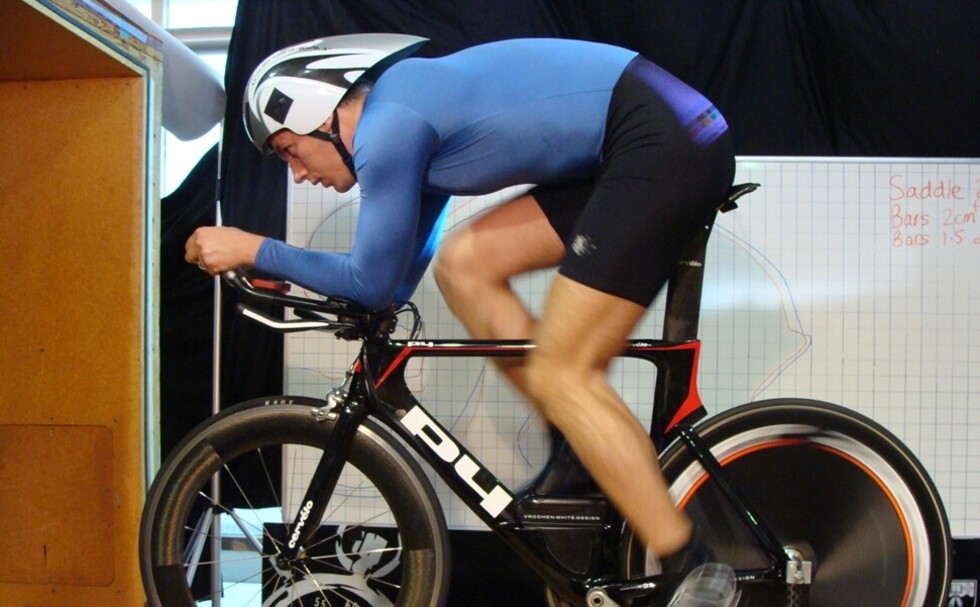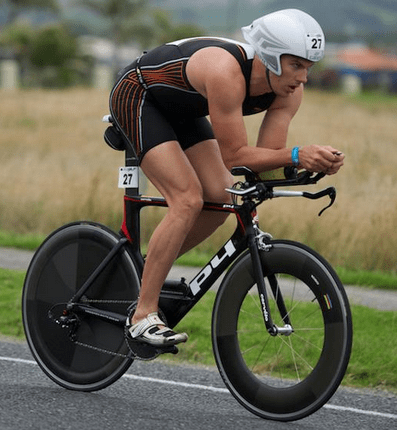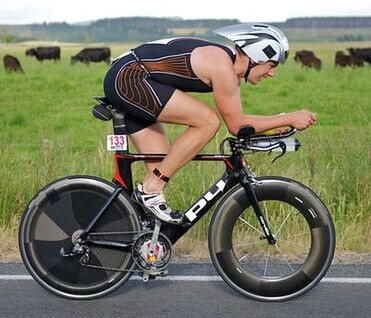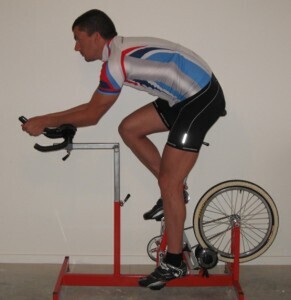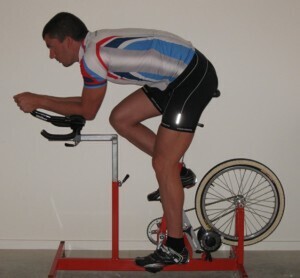I can always tell when the mood of the triathlon community turns from winter hibernation to preparing for a new season – I get a surge of enquiries about bike fit. As I’m seeing fresh signs of activity for the coming summer (and the Half IM season is upon us in the North Island) I thought it appropriate to discuss why bike fit is important and how you can tell whether you need to pay attention to yours.
I’m going to focus on triathlon bike positioning for this article. The principles for a road bike fit (with or without aerobars) are similar but there is enough of a difference to make the article confusingly complicated if I try to cover off everything in one hit.
The overwhelming trend that I see at races is that athletes have spent a small fortune on their tri bike but are not getting the benefit thanks to poor position.
So I’m going to list some common problems and solutions.
The over-riding (pun intended) problem that I see is riders who cannot stay in their aerobars for the entire ride. The whole point of a tri bike is to be in the aerobars – the bikes are neither comfortable nor fast when you’re sitting up. In my own case my aerodynamic drag increases by nearly 30% when I sit up off the aerobars- as I’m not so strong that I can overcome that penalty I make sure I can stay tucked for the entire duration of the race.
There are several possible causes of this inability to stay tucked, so I’ll address each cause/solution individually.
1. Saddle Height
In nearly ten years of bike set ups I’ve put the saddle up for Five (5) people (nearly all others have needed to go down). And when I watch races it’s clear that the most common problem is having the saddle too high, sometimes by as much as 8cm (we refer to this as ‘going all the way up’).
The primary symptom of excessive saddle height is back pain – usually riders will drop their hips to reach the pedals and this causes unnecessary motion for the lower spine, which makes it sore. Hamstring or Gluteal issues as well as tightness in the calves are also common side effects. A useful rule of thumb is that pain above the knee on the front of the thigh suggests a too low saddle and pain above and behind the knee indicates too high.
Often, if a rider complains of a sore back, the response from a bike shop will be to raise the handlebars. But this doesn’t deal with the underlying issue. I can’t emphasise this enough – getting the saddle height right is the key to being able to achieve a good position – if it’s wrong then any other adjustments made to your position are just fiddling in the margins and doomed to failure.
2. Aerobar Length
Demonstrating correct extension length and compact reach.
R/S bend or straight aerobars are a curse for triathlon bikes – they’ve exacerbated the position issues of a legion of Triathletes in the last 6 years. The right extension length allows your elbow to sit on the pad with your hands comfortably holding the near the shifter. For most people this is best achieved by a J/Ski bend extension that curves up to give a nice relaxed wrist angle. You don’t want to have to move to use the shifters – the whole purpose of bar end shifting is to be able to shift when in the aerobars.
If your forearms feel bruised (some even get abraded) after a ride or you have a really sore neck, shoulders and/or triceps then aerobar length is a strong candidate for correction. And if you have to move your hands a long way to change gears then you definitely need to change the aerobar length.
3. Reach to the Aerobars
Most riders have their bars too far away. The consequence of this is the rider pulling back on the aerobars to reduce the reach but this just puts more strain on the back and shoulder muscles once the elbows come off the pads. The pads need to be under the elbows and below the shoulders. This allows the weight of the upper body to be supported by the skeleton (which doesn’t get tired in a hurry) instead of the muscles (which fatigue quite quickly).
Mid back and shoulder/neck pain are strong indicators of incorrect reach along with not being able to stay in the tucked position.
Aside from these major issues there are a bunch of other factors that can have a marked effect on comfort:
An Example
What I see at races and when clients first come in.
Rather than embarrassing anyone else I’ll simulate common incorrect and corrected positions.
This is a pretty typical position:
- Saddle is too high (leg too straight and toes pointed)
- Aerobars too short
- Bars too far away
- Saddle pointed down
This combination leads to shoulder, lower back, hip flexor and knee pain. And that devilish mix leads to sitting up in the latter half of your race and coming in for a disappointing bike times.
New & Improved version
And this is where we aim to end up.
Note that the longest setting for these aerobars is still too short for me and the race pic further up shows my actual position.This position is, despite being lower and faster, a lot more comfortable and easier to stay in for the whole race. Which is a win from every angle. Saddle is level and the right height, aerobars are supporting torso weight and the reach to the bars is comfortable.
Saddles
Pretty obvious this one. You can never spend enough on contact points – if you have a saddle that causes discomfort (chafing, perineal pressure, not sitting straight) you could be throwing away all the money you’ve spent on the rest of your equipment. ISM Adamo saddles are a popular design as they’ve removed the front 6cm of the saddle – removing the opportunity for pressure. However, they just don’t work for some riders (including me) and the Cobb V-Flow range is a good option for those who want a more traditional saddle shape with concessions to the way tri bikes are ridden.There are a couple of systems that use ‘butt-o-meters’ to assess which saddles could work for a rider – these are very rough and can be helpful for a new rider.
But if you’ve already spent a lot of time on a bike you’ll achieve more by identifying what is wrong about the current saddle and looking for an alternative that (may) solve those issues. Ultimately the only way to determine whether a saddle works is by testing. Some distributors offer test programs for their saddles notably San Marco (PRV) and Cobb(Sweat7). Whether a saddle works or not is highly dependent on having it set up correctly – if it is so high that you have to rock on it to reach the pedals it’s very unlikely that any saddle will feel good. Even worse is when the saddle has been pointed down to compensate for being too high – then you’ll be constantly pushing back and significantly increasing the load on your knees (and it’s not like Triathletes need any more help to irritate their ITB!).
Much as a poor position can spoil what would otherwise be a good saddle. So too the wrong saddle can ruin what would otherwise be a good position. If it causes you to rotate your pelvis back to avoid placing pressure on the nose (because it’s hurting your soft bits) then your reach, back comfort and power production will be compromised. Which brings me back to my first point in this section, which I’ll repeat for emphasis – contact points are the most important area to spend money on.
Drop to the bars
Generally I find that riders can tolerate a lot more drop than they thought possible once the fundamentals above are addressed correctly. Obviously if you have issues, caused by past injuries or degeneration, care has to be taken in this area. The main focus is to be considerate of your neck and the way you ride but for most athletes drop stops being such a major influence on comfort once the weight of the torso is being borne by the skeleton.
Shoes/pedals
Another important contact point – numbness (from shoe constriction or cleat placement) is bad. Putting the cleats as far back as possible can save your calves for the run as well.
Aerobar Pads
Usually closely related to the extension shape. You’ll end up resting quite heavily on the pads so it’s important to make sure they’re appropriately supportive – good surface area and nicely cupped around your arm with a firm foam cushion. If you have bolts pushing through the cushioning it will probably make it harder to stay aero – so keep an eye on the condition of your pads.
Adaptation
Of course, there is only so much that can be achieved with position – obviously you need to spend time on the bike practicing your aerobar discipline. Top athletes only get out of the aerobars for aid stations, corners, transitions and steep hills (rolling hills are done on the aerobars). Long rides staying in the aerobars are a good time to identify issues with your position that need to be addressed before race day.
The off season is the ideal time for experimenting with position assuming that you keep riding (there is little point if you’re not going to be on the bike enough to adapt to any changes). If you’re getting back into training now it’s a good time to sort out your set up for the coming season. So have a look at pictures of yourself from last season, think about how well you stayed in the aerobars in races and pay attention to the warning signs I’ve listed when you’re out training.
Especially if you’re thinking about a new bike for this season – make sure you have your position sorted first. It’s pretty sad to turn up for a bike fit with your new toy to be told that it’s the wrong size and that you’ve wasted $$$$ (I don’t enjoy telling people this – so no one wins in this situation). A good bike fitter will be able to calculate which bikes will best match your position to make sure that you’re set up with maximum elegance (minimal spacers, good handling and optimal aerodynamic efficiency). You may notice in the photos that I use an adjustable fit bike to determine the correct position to then narrow the search for a new bike to those that fit best.
And if you do go to a fitter, it’s well worth making notes of problems during your rides in the couple of weeks before the fit session. A good fitter uses general rules to get you in the ball park and then tweaks to optimise for you as an individual based on observation and the feedback you give. So the better the information you can give about the issues you’ve had the better the outcome will be.
And if you’re considering getting a bike fit done, may I suggest that we should talk…
